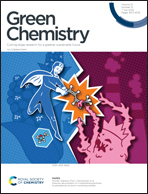Solvent-free ageing reactions of rare earth element oxides: from geomimetic synthesis of new metal–organic materials towards a simple, environmentally friendly separation of scandium†
Abstract
The development of cleaner methodologies for the separation and processing of rare earth elements, including scandium and yttrium, is of high importance to materials science and industry. Here, we explore the use of simple, solvent-free and low-energy “accelerated ageing” reactions, inspired by geochemical processes of mineral weathering and neogenesis, to convert eight rare earth (RE) element oxides, specifically Sc, Y, La, Yb, Eu, Gd, Lu and Nd, into metal–organic oxalate derivatives. The reactions can readily be directed towards the formation of topologically distinct framework structures by introduction of additional oxalate ions in the form of simple alkaline metal or ammonium salts, providing not only simple, solvent-free access to novel metal–organic RE element architectures from readily accessible precursors, but also enabling a proof-of-principle of a simple route to separate scandium from at least seven other rare earth elements in a mixture of metal oxides. Specifically, the metal–organic structures obtained by ageing a mixture of scandium and other RE element oxides in presence of ammonium or sodium oxalates exhibit significant differences in aqueous solubility at boiling point of water, providing high scandium separation factors ranging from approximately 102–103, without requiring elaborate complexation reagents, toxic extractants, acidic media, or solvents other than water.



 Please wait while we load your content...
Please wait while we load your content...